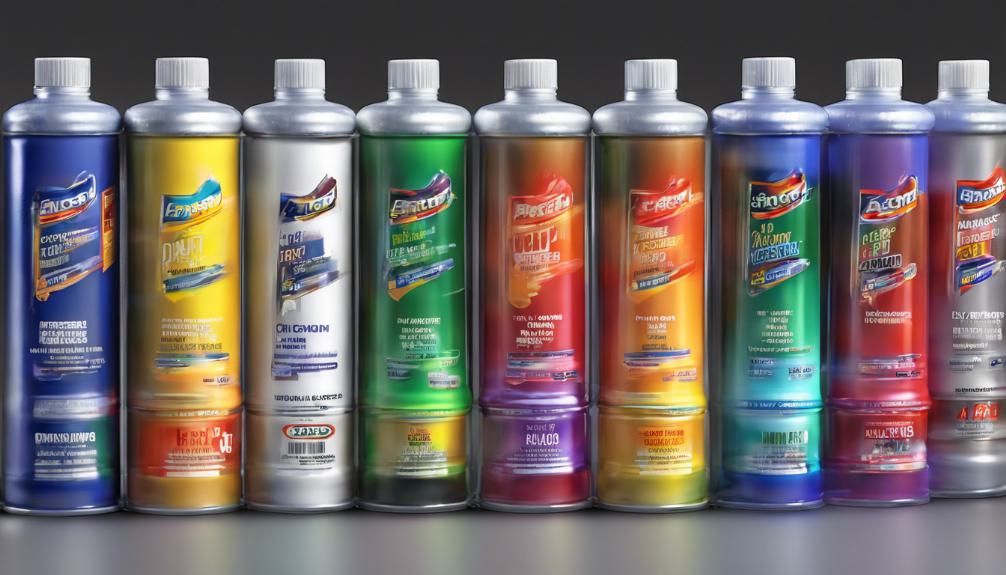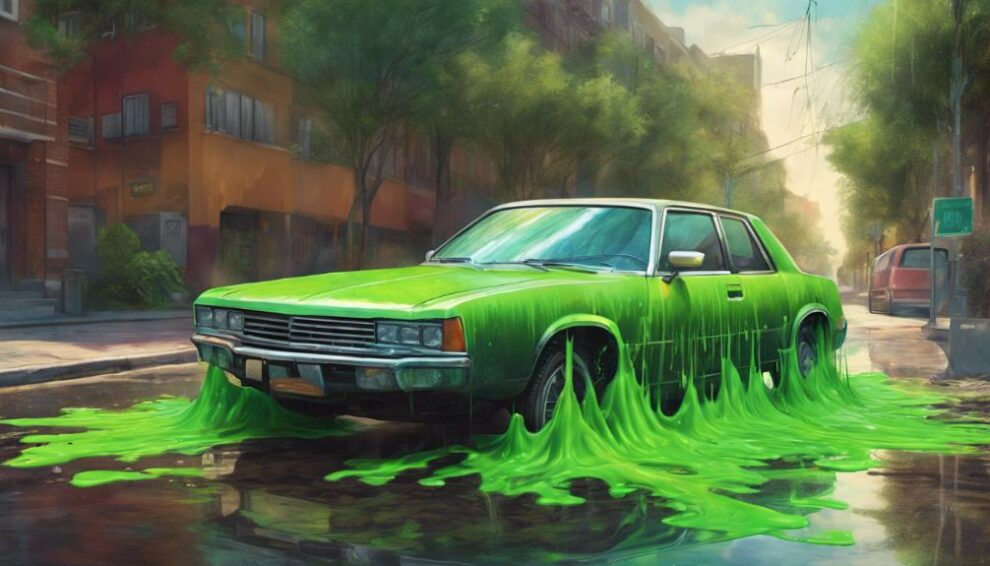Analyzing your radiator fluid color can reveal essential information about your car’s health. Different coolant colors don’t reflect chemical types but aid in visual identification.
Browns or sludgy fluid might signal engine issues, while white smoke and coolant loss could point to a cracked cylinder head. Rust-colored coolant may indicate system corrosion.
Mixing coolants can lead to harmful reactions, impacting your cooling system. Choose the correct coolant type following your car manual’s recommendations to prevent engine damage.
Remember, proper coolant selection is important for your vehicle’s well-being. Addressing fluid concerns promptly ensures excellent engine performance and longevity.
What You Need to Know
- Radiator fluid color aids in visual identification of coolant type.
- Color doesn’t reflect chemical composition; refer to manual for type.
- Different colors historically associated with unique coolant compositions.
- Incorrect coolant type can damage the engine; follow manufacturer’s recommendations.
- Address any color changes promptly to prevent potential engine issues.
Importance of Radiator Fluid Color

Understanding the importance of radiator fluid color in your car maintenance routine can help you make informed decisions regarding coolant selection.
Coolant identification based on color can be a common misconception among car owners.
The color of radiator fluid doesn’t necessarily indicate a specific coolant type; rather, manufacturers use dye to differentiate between brands and types.
It’s vital to recognize that the color of coolant—whether it’s pink, red, purple, green, orange, blue, or yellow—is primarily for visual identification purposes.
Relying solely on the color of radiator fluid to determine the coolant type can lead to confusion.
Manufacturers purposefully dye coolants for visual distinction rather than to reflect their chemical composition.
Therefore, referring to your car manual for the recommended coolant type is essential for proper maintenance.
Understanding Coolant Types by Color
When identifying coolant types based on color, it’s important to note that historically, different chemical compositions were associated with coolant colors like green, blue, orange, red, purple, pink, and turquoise.
Green and blue coolants typically used Inorganic Additive Technology (IAT), while orange and red coolants used Organic Acid Technology (OAT) or Extended Life Coolant (ELC).
However, modern coolants no longer strictly adhere to color-coding for specific types, making it crucial to refer to the car manual for the recommended coolant type.
Color misconceptions can lead to using the wrong coolant, risking damage to your engine.
To make sure you choose the correct coolant composition, always follow the manufacturer’s recommendations.
If unsure of the current coolant type in your vehicle, opt for a universal coolant like Prestone to prevent any adverse reactions from mixing different coolant types.
Signs of Potential Engine Issues

If you notice a sudden change in your radiator fluid color, such as turning brown or sludgy, it could be a sign of potential engine issues.
Brown or sludgy coolant might indicate contamination or overheating problems within the engine.
Troubleshooting tips include checking for foamy or milky fluid, which could suggest a leaking head gasket mixing coolant with engine oil.
Besides, if you observe white smoke coming from the exhaust along with radiator fluid loss, it could be a sign of a cracked cylinder head or engine block.
Rust-colored coolant may signal corrosion in the cooling system, often caused by lack of maintenance or water contamination.
Diagnostic indicators like a strong sweet smell or visible oil slick in the coolant may point to leaks into the engine cylinders, potentially causing mechanical damage.
Regularly inspecting your radiator fluid and addressing any color changes promptly can help prevent further engine issues.
Compatibility and Mixing Concerns
Mixing different colored radiator fluids without proper consideration can lead to chemical reactions and potential damage to your vehicle’s cooling system.
Fluid compatibility is vital when it comes to maintaining the health of your car’s engine.
Universal coolants like Prestone are designed to be safely mixed with different types of radiator fluids, but using the wrong one can result in costly repairs and potential engine damage.
To avoid these issues, always consult your car manual or a mechanic for guidance on radiator fluid compatibility and mixing precautions.
Address any concerns about fluid compatibility promptly to prevent potential issues with the cooling system. Taking the time to make sure that the fluids you’re using are compatible can save you from encountering major problems down the road.
Recommendations for Correct Coolant Selection

For peak performance and compatibility, selecting the appropriate coolant type as recommended in your car manual is vital.
Your vehicle’s cooling system relies on the proper coolant selection to maintain peak functioning.
Using the recommended coolant guarantees that the chemical composition is compatible with your engine and radiator materials, preventing damage and corrosion within the system.
It’s essential to avoid mixing different coolant colors, as this can lead to chemical reactions that may harm your cooling system components.
If you’re unsure about the current coolant type in your car, opting for a universal coolant like Prestone can be a safe choice.
Selecting the wrong coolant can result in costly repairs, highlighting the importance of adhering to the coolant specifications outlined in the owner’s manual.
Maintenance Tips for Radiator Fluid
To maintain peak engine performance, make sure to have regular coolant changes as per the recommended intervals based on the type of coolant in your vehicle.
Coolant change frequency varies depending on the type of coolant your vehicle uses.
For IAT coolant, it’s important to change it every 24,000 miles or every 2 years to keep your engine running at its best.
On the other hand, OAT and HOAT coolants should be changed every 150,000 miles or every 5 years for extended service life.
Regular coolant changes are essential as they help prevent corrosion in the cooling system, which can lead to engine overheating and costly repairs.
Neglecting coolant maintenance can result in decreased efficiency and potential engine damage.
Also, make sure to conduct regular coolant inspections to catch any leaks early on. Addressing coolant leaks promptly is crucial to prevent engine overheating and avoid expensive repair bills.
Stay proactive with your coolant maintenance to ensure your engine stays in top condition.
As an Amazon Associate we earn from qualifying purchases.










